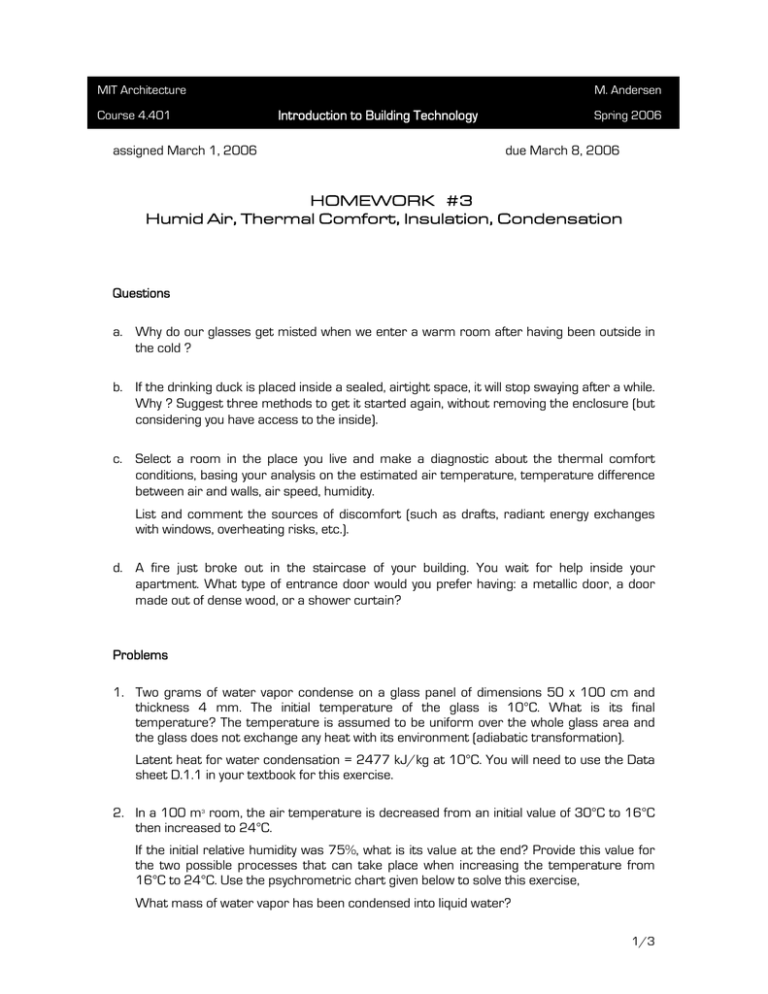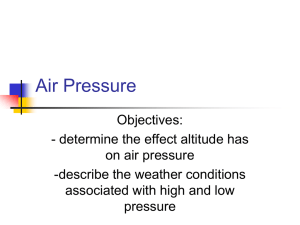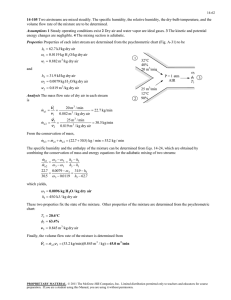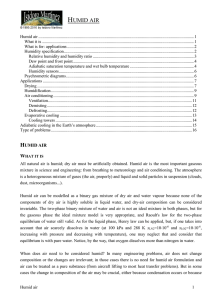HOMEWORK #3 Humid Air, Thermal Comfort, Insulation, Condensation
advertisement

MIT Architecture Course 4.401 assigned March 1, 2006 M. Andersen Introduction to Building Technology Spring 2006 due March 8, 2006 HOMEWORK #3 Humid Air, Thermal Comfort, Insulation, Condensation Questions a. Why do our glasses get misted when we enter a warm room after having been outside in the cold ? b. If the drinking duck is placed inside a sealed, airtight space, it will stop swaying after a while. Why ? Suggest three methods to get it started again, without removing the enclosure (but considering you have access to the inside). c. Select a room in the place you live and make a diagnostic about the thermal comfort conditions, basing your analysis on the estimated air temperature, temperature difference between air and walls, air speed, humidity. List and comment the sources of discomfort (such as drafts, radiant energy exchanges with windows, overheating risks, etc.). d. A fire just broke out in the staircase of your building. You wait for help inside your apartment. What type of entrance door would you prefer having: a metallic door, a door made out of dense wood, or a shower curtain? Problems 1. Two grams of water vapor condense on a glass panel of dimensions 50 x 100 cm and thickness 4 mm. The initial temperature of the glass is 10°C. What is its final temperature? The temperature is assumed to be uniform over the whole glass area and the glass does not exchange any heat with its environment (adiabatic transformation). Latent heat for water condensation = 2477 kJ/kg at 10°C. You will need to use the Data sheet D.1.1 in your textbook for this exercise. 2. In a 100 m3 room, the air temperature is decreased from an initial value of 30°C to 16°C then increased to 24°C. If the initial relative humidity was 75%, what is its value at the end? Provide this value for the two possible processes that can take place when increasing the temperature from 16°C to 24°C. Use the psychrometric chart given below to solve this exercise, What mass of water vapor has been condensed into liquid water? 1/3 3. On a plain at 200 m altitude, fresh (18°C) and humid (HR=70%) air is flowing from South to North. It passes a 2500 m high mountain range and thereafter flows down to a second plain situated at 400 m altitude. Using the psychrometric chart given below and knowing that the temperature of non-saturated air decreases by 10 °K every 1000 m altitude (dry adiabatic gradient) and by 6 °K every 1000 m for air saturated in water vapor (humid adiabatic gradient), answer the following questions: On what side of the mountain and at what altitude does condensation start (i.e. will be observe the cloud’s base) ? What are the temperature and relative humidity of the air at the top of the mountain ? What do these values become when the air reaches the second plain ? 120 130 110 30 0.9 50 % 90 90 80 60 tb ulb % 23 tem 22 per a tur 40 % C) 50 0 0 ) 19 18 ( re tu ra te tio ra tu ya .92 5 20 15 20 5 o tive 15 0 Rela o 0 30 35 Dry bulb temperature( C) 20 3 Enthalpy(kj/kg) 30 70 60 2 1 00 25 0.75 0.80 0.85 0.90 0.95 1.00 4 0.9 10 20 0.70 5 idit hum 75 15 80 9 6 % y 10 0.8 0 10 0 25 00 5 0.85 0.8 0.8 0 10 7 o 20 0.65 90 8 25 10 11 ir 0 20% 0.55 0.60 12 )dr 30 o 30 0 100 13 /kg n 2 15 Sa 14 e(m m pe lum 15 0.45 0.50 16 Vo o 25 30% 10 110 17 % 40 20 35 40 0.40 20 0C t 50 120 21 e(3 se t En 26 24 We % 70 25 j/k (k py 60 l ha 27 25 % 80 70 0.35 28 30 g) 130 29 100 40 45 50 0 50 40 Image by MIT OCW. Design Project Collect data Please provide the list of the data you have gathered from the sources identified in the last homework assignments (and additional ones if needed) to be able to establish a thermal balance for your building. If some of your data are based on assumptions, please describe these assumptions and comment on their adequacy. 2/3 The level of precision your will reach for your thermal balance will depend on what information you have access to and how you use it. Please comment on the reliability of your data and on their expected accuracy and applicability. Don’t worry if you cannot get precise numbers. Once more, what counts is only to have the right order of magnitude and to base your conclusions on correct suppositions and method. The data that you collect should cover: reasonable indoor and outdoor temperatures and humidity for early March; reasonable value for solar irradiation on the façades; rough (average) number of people living in the building, rough estimation of the number and type of appliances and lighting elements; materials that make up the building’s envelope and the windows; orientation of the different façades; rough estimation of obstructions around the building created by the surroundings; volumes involved and recommended (possibly adjusted) air renewal rates. Reading assignment from textbook “Introduction to Architectural Science” by Szokolay: § 1.1.3 + § 1.2 + § 1.4.3 - 1.4.4 + § 1.5.4 Additional readings relevant to lecture topics: "How Buildings Work" by Allen: Chap 7 + Chap 8 + Chap 12 "Heating Cooling Lighting" by Lechner: Chap 4 + Chap 15 3/3







